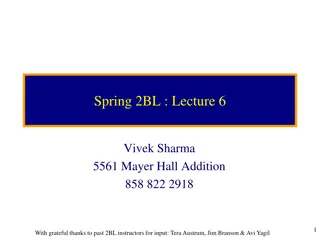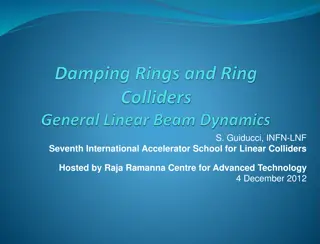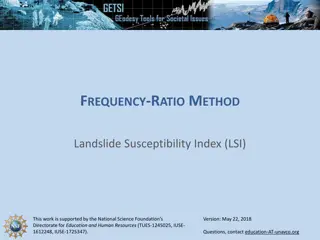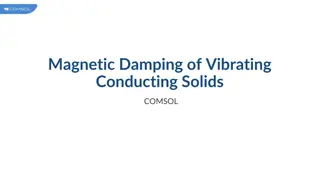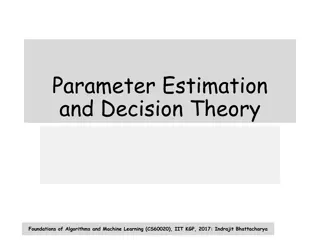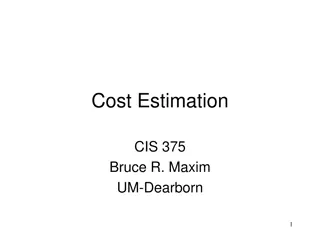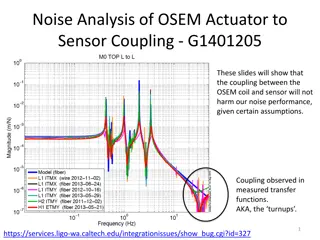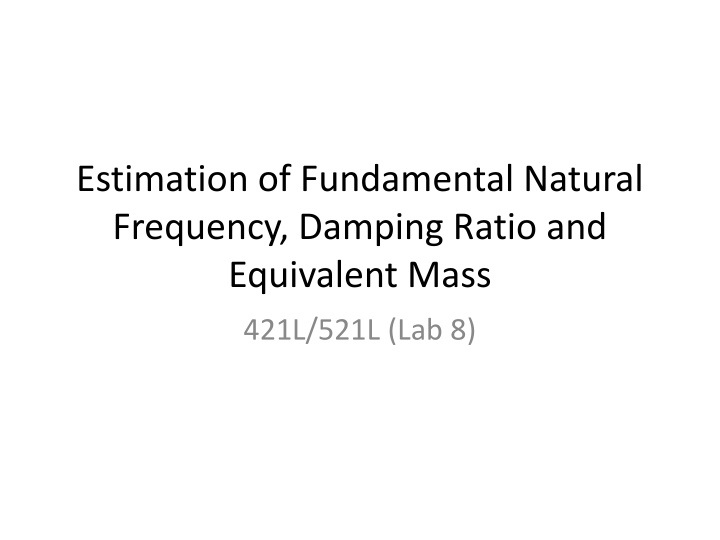
Estimation of Fundamental Frequency, Damping Ratio, and Equivalent Mass in Structural Dynamics
This laboratory experiment focuses on estimating fundamental natural frequency, damping ratio, and equivalent mass in structural dynamics using single degree of freedom modeling and acceleration measurements. The experiment involves identifying mode characteristics, measuring responses, and applying the Rayleigh method for estimation. It also explores the influence of an accelerometer's mass on the calculations.
Download Presentation

Please find below an Image/Link to download the presentation.
The content on the website is provided AS IS for your information and personal use only. It may not be sold, licensed, or shared on other websites without obtaining consent from the author. If you encounter any issues during the download, it is possible that the publisher has removed the file from their server.
You are allowed to download the files provided on this website for personal or commercial use, subject to the condition that they are used lawfully. All files are the property of their respective owners.
The content on the website is provided AS IS for your information and personal use only. It may not be sold, licensed, or shared on other websites without obtaining consent from the author.
E N D
Presentation Transcript
Estimation of Fundamental Natural Frequency, Damping Ratio and Equivalent Mass 421L/521L (Lab 8)
Single DOF Modeling accelerometer E, I, L, Cantilever c k E, I, L, Fixed-Fixed M E: Young s modulus I: Moment of inertia L: length : mass per unit length x k, stiffness, N/m m, mass, kg c, damping coefficient, N/(m/s) mx +cx +kx = f(t) x(t) = Aexp(- nt)COS( nsqrt(1- 2)t- )+Bsin( t) Time response = Transient response + Forced response(sinusoidal) Where, n=sqrt(k/m), undamped natural frequency, rad/s =c/sqrt(2mk), damping ratio d= nsqrt(1- 2), damped natural frequency, rad/s
Visualization of responses Sinusoidal part Exponential part 1 0 -1 Transient response 0 0.5 1 1.5 2 2.5 3 3.5 4 4.5 5 1 0 -1 0 0.5 1 1.5 2 2.5 3 3.5 4 4.5 5 5 Forced response (Sinusoidal input) 0 -5 0 0.5 1 1.5 2 2.5 3 3.5 4 4.5 5 5 Transient response + Forced response 0 -5 0 0.5 1 1.5 2 2.5 3 3.5 4 4.5 5
Experiment Identify the fundamental mode characteristics using logarithmic decrement Mount Accelerometer onto beam End for cantilever beam Center for fixed-fixed beam Excite beam by applying impulse or initial displacement Observe transient response (No forced response) Collect time response Pick two peaks and measure amplitude and period Find natural frequency, damping ratio Find equivalent mass from beam equation Find damping coefficient and stiffness
? Equivalent mass and natural frequency estimation by Rayleigh method (See the handout) Cantilever Beam meq = 0.2235 L n=3.6639sqrt(EI/( L4)) rad/s Fixed-Fixed Beam meq = 0.3836 L n=22.373sqrt(EI/( L4)) rad/s Does your measurement match to your estimation? Show your measurement and measured value What if you count the mass of the accelerometer?
Experimental setup: Cantilever Beam Aluminum Beam Thickness = 4.84mm Width = 19.09mm Length = 640mm Accelerometer is mounted at the end of the beam Mass of accelerometer = 7.83 gram
Cantilever Beam NOTE: X1,2 = time in s, y1,2 = acceleration in g, (m = mili )
Work Sheet: Cantilever Beam # Item Unit Value # Item Unit Value A Time @ peak #1 s H Damped natural frequency, d I Natural frequency, n J zeta rad/s B Time @ peak #2 s rad/s C Amplitude @ peak #1 g D Amplitude @ peak #2 g K Equivalent mass, meq L Stiffness, k kg E Time between A and B s N/m F Number of periods between A and B MDamping, c N/(m/s) N Natural frequency estimation by Rayleigh method rad/s G Period of oscillation, E/F s
Experimental setup: Fixed-Fixed Beam Aluminum Thickness = 4.84 mm Width = 19.09 mm Length = 640 mm Accelerometer is mounted at the center Mass of accelerometer = 7 .83 gram
Fixed-Fixed Beam NOTE: X1,2 = time in s, y1,2 = acceleration in g, (m = mili )
Work Sheet: Fixed-Fixed Beam # Item Unit Value # Item Unit Value A Time @ peak #1 s H Damped natural frequency, d I Natural frequency, n J zeta rad/s B Time @ peak #2 s rad/s C Amplitude @ peak #1 g D Amplitude @ peak #2 g K Equivalent mass, meq L Stiffness, k kg E Time between A and B s N/m F Number of periods between A and B MDamping, c N/(m/s) N Natural frequency estimation by Rayleigh method rad/s G Period of oscillation, E/F s
Different material? Repeat the experiment with Steel and any nonmetal material Compare the result

